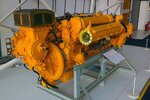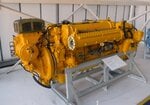(I hope it's okay to reactivate an old thread)
The Packard Merlin: How Detroit Mass-Produced Britain's Hand-Built Powerhouse - Tested.com
A quote, word for word from the book ''The Merlin In Perspective'' by Alec Harvey-Bailey (RR Heritage Trust)
As an added note: The RM17SM was fully cleared and type-tested @ 2,200hp but was never used. These modifications were included in the V1650-9
RM17SM additional info from this book:
Max Type Tested HP (3000rpm +30lbs boost) = 2,200hp
Max Flight Clearance Tested Power = 2,340hp
Max Endurance Tested Power (3000rpm +36lbs boost Water Injection) = 2,640hp
Longest High Power Development Test. 100hours @ 3000rpm +18lbs boost) Two successful tests.
Source: The Merlin In Perspective, Page 84.
The Packard Merlin: How Detroit Mass-Produced Britain's Hand-Built Powerhouse - Tested.com
A quote, word for word from the book ''The Merlin In Perspective'' by Alec Harvey-Bailey (RR Heritage Trust)
"Packard built engines to very high standards of quality. Technical problems were not dissimilar from those experienced on British engines and when comparing like with like modification standards there was nothing to choose between engine sources.
At squadron level there were times when there were fortuitous variations in reliability either way but when dealing with large numbers at Group or Command level there was good consistency in results between British and Packard engines.
The 60,000 engines produced by Packard for the RAF and USAAF were of inestimable value.''..
As an added note: The RM17SM was fully cleared and type-tested @ 2,200hp but was never used. These modifications were included in the V1650-9
RM17SM additional info from this book:
Max Type Tested HP (3000rpm +30lbs boost) = 2,200hp
Max Flight Clearance Tested Power = 2,340hp
Max Endurance Tested Power (3000rpm +36lbs boost Water Injection) = 2,640hp
Longest High Power Development Test. 100hours @ 3000rpm +18lbs boost) Two successful tests.
Source: The Merlin In Perspective, Page 84.



